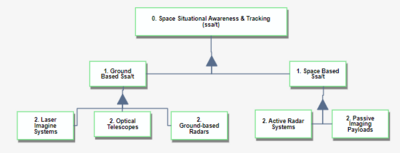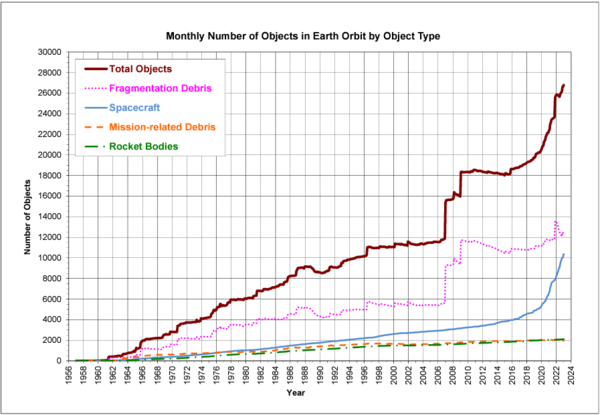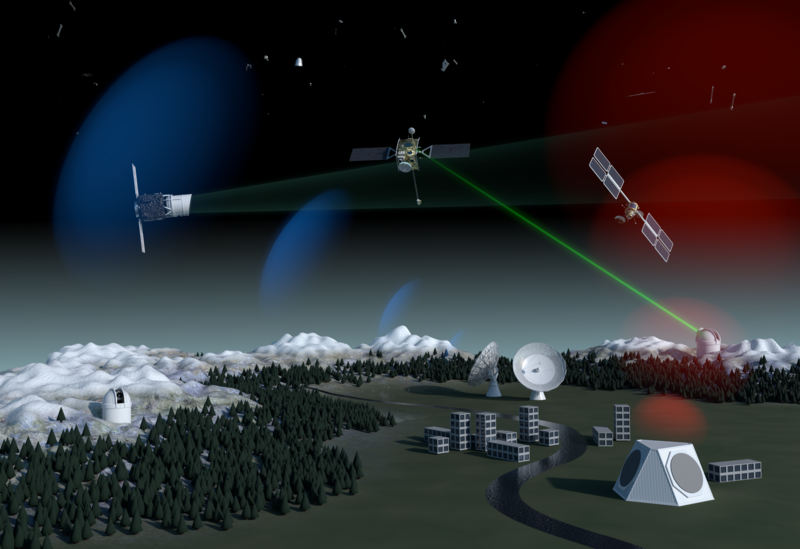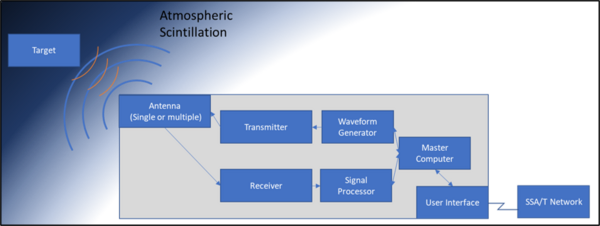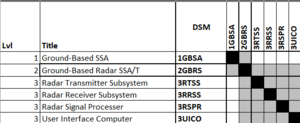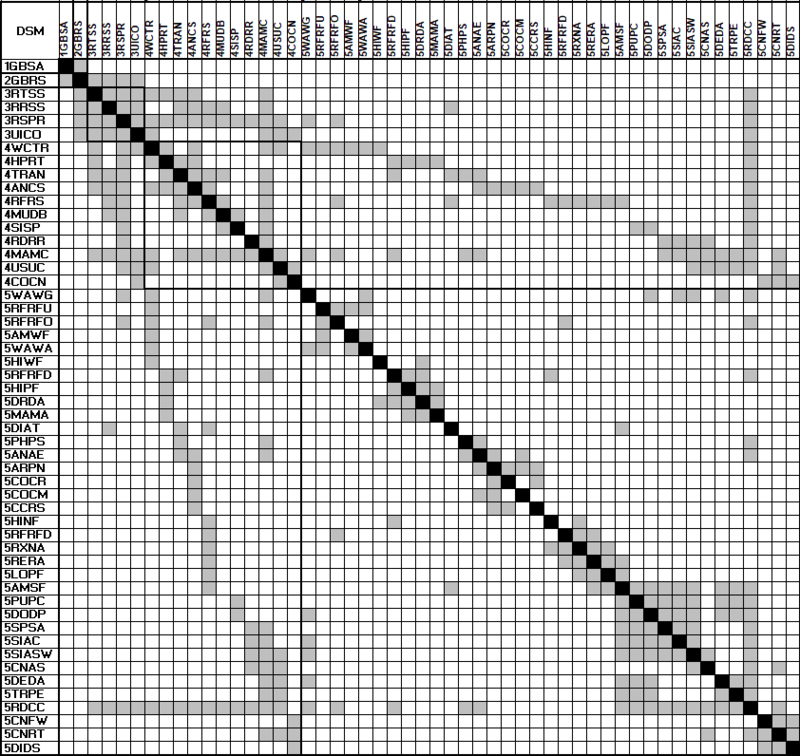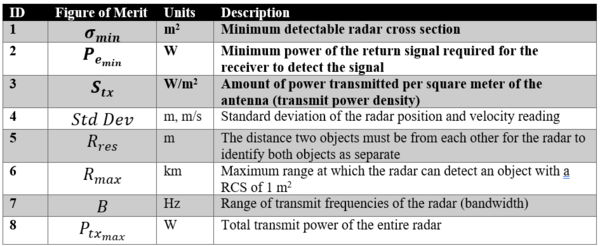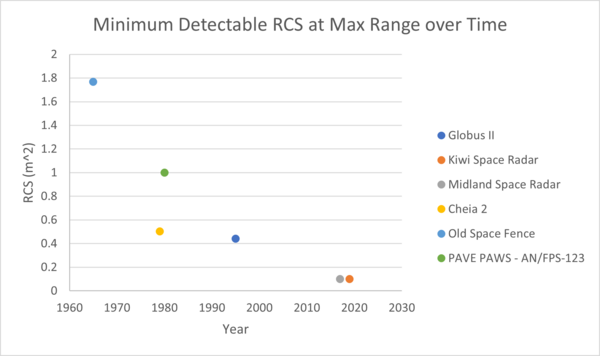Difference between revisions of "Ground Based Radar For Space Situational Awareness"
| Line 54: | Line 54: | ||
==Roadmap Model using OPM== | ==Roadmap Model using OPM== | ||
The Object-Process Diagram (OPD) is of a Ground-based Radar with the mission of tracking Resident Space Objects (RSOs) in support of Space Situational Awareness. The Radar has four primary subsystems: the Radar Transmitter Subsystem, Radar Receiver Subsystem, Radar Signal Processor System, and the User Interface Computer. These four subsystems operate the process of transmitting radio waves to reflect off a RSO target, receiving the return reflected radio waves, and then processing the received radar data into digital tracks to be displayed to an operator and passed to external communication networks. The entire OPD and OPL is included in a separate attachment. | |||
[[File:Ground-based Radar OPD (Problem Set #2).jpg|400px]] | |||
==Figures of Merit== | ==Figures of Merit== | ||
Revision as of 14:03, 12 October 2023
Technology Roadmap Sections and Deliverables
This technology roadmap is identified as:
- 2GREAT - Ground Based Radar For Space Situational Awareness
Or as Ground-based Radar to Enable Awareness and Tracking (GREAT)
Space Situational Awareness and Tracking (SSA) is the operational concept to detect, identify, and track Resident Space Objects (RSOs), orbiting around the Earth. The SSA/T enterprise is comprised of ground-based and space-based sensors with a broad customer base. SSA originated from the need to track RSOs in orbit to support data analysis and collision avoidance of active satellite vehicles (SVs), inactive SVs, and orbital debris. As of 1 September 2023, the European Space Agency estimates about 8600 functioning SVs, over 1,036,500 objects greater than 1cm, and more than 11,000 tonnes of mass in orbit1.
The figure below illustrates the levels within the SSA/T enterprise. Many systems comprise the architecture, each with technological challenges, advantages, and disadvantages.
Ground Based Radar For Space Situational Awareness and the SSA Enterprise
Roadmap Overview
SSA was initiated in the 1950s to support missile warnings of intercontinental ballistic missiles. The first of these radars was developed to identify and track missiles when they reach the apogee of their suborbital flight and begin their re-entry. In 1955, shortly after the sub-orbital radars began operation, the Soviet Union launched its first satellite, and a new space race began. With the growing concern about the need to track low earth orbit (LEO) satellites, most suborbital missile warning radars began to support detecting and tracking satellites.
Today, over 26,000 objects over 10 cm are tracked by the United States SSA network, and countless more pieces of debris under 10 cm. This debris poses a risk to satellites in orbit, space stations, launch vehicles, and satellites transit through orbits.
Amount of Orbital Debris by Type, from NASA Quarterly "Orbital Debris" March 2022 Newsletter, Accessed 2 October 2023 https://orbitaldebris.jsc.nasa.gov/quarterly-news/pdfs/ODQNv27i1.pdf
The Ground-based SSA network consists of multiple active and passive sensors. The most capable systems are ground-based radars. A ground-based SSA radar has varying subsystem architectures such as phased arrays, single arrays, monostatic, or bi-static systems. Each radar system varies in frequency and power based on the needs of that radar site. Many SSA systems are networked to support the shared object identification and tracking catalog.
Artist's impression of various SSA systems comprising a full SSA architecture. “Space Surveillance and Tracking - SST Segment.” Accessed October 1, 2023. https://www.esa.int/Safety_Security/Space_Surveillance_and_Tracking_-_SST_Segment.
Broadly speaking, a ground-based radar consists of a radar transmitter and receiver, a master computer, and a user interface. The system emits a high-power waveform and then attempts to identify radar returns from the received noise. This process is not trivial. The system must transmit with enough power to overcome path loss, which reduces the range of a radar by Range4, and Atmospheric Scintillation in both directions. The return signal is often so faint that the main computer must use advanced signal processing and detection algorithms to find the return signal in the noise. The signal must then be tracked to collect its azimuth and elevation from the radar and the range and range rate. This data can then be used to identify and provide the object's location, as a two-line element, to cataloging agencies such as the United States Space Force.
Diagram showing Ground-Based Radar Overview
This Roadmap will explore what technology has driven the success of SSA radars, how to optimize the system further, and what innovative, potentially disruptive, technologies are on the horizon.
Design Structure Matrix (DSM) Allocation
The DSM below provides a NxN mapping of the ground-based radar SSA system technologies. The DSM identifies the connective relationship between elements within the matrix (grey).
Roadmap Model using OPM
The Object-Process Diagram (OPD) is of a Ground-based Radar with the mission of tracking Resident Space Objects (RSOs) in support of Space Situational Awareness. The Radar has four primary subsystems: the Radar Transmitter Subsystem, Radar Receiver Subsystem, Radar Signal Processor System, and the User Interface Computer. These four subsystems operate the process of transmitting radio waves to reflect off a RSO target, receiving the return reflected radio waves, and then processing the received radar data into digital tracks to be displayed to an operator and passed to external communication networks. The entire OPD and OPL is included in a separate attachment.
File:Ground-based Radar OPD (Problem Set
Figures of Merit
The table below shows the Figures of Merit (FOMs) that can be used to assess the improvement of Ground-Based Radars for Space Situational Awareness. The key FOMs are indicated in bold.
The governing equations for the key FOMs are listed in the table below. Note that the first two equations are both interpretations of the radar range equation.
Data collection was limited due to the highly propriety nature of commercial systems (e.g., LeoLabs) or due to the information protection enforced on military-funded programs (e.g., MIT Milestone or Lockheed Martin’s Space Fence). However, the team was able to collect and compare the advertised minimum detectable radar cross-sections at each system’s stated range. A plot of the minimum detectable radar cross-sections at maximum range over time can be seen below.
Notice that the trend is sloping downwards and beginning to level out. The downward slope indicates an improvement of the technology over time. The minimum detectable radar cross section can never be zero, as it is not physically possible to see something with a diameter of 0 meters. However, the goal, and thus theoretical limit, would be to approach zero.
Alignment with Company Strategic Drivers
Positioning of Company vs. Competition
Technical Model
Financial Model
List of Demonstrator Projects
Key Publications, Presentations and Patents
Technology Strategy Statement
References
[1] European Space Agency, Space Environment Statistics, Accessed 1 October 2023 https://www.esa.int/Space_Safety/Space_Debris/About_space_debris#:~:text=In%20more%20than%2060%20years,10%20cm%20in%20low%2DEarth
